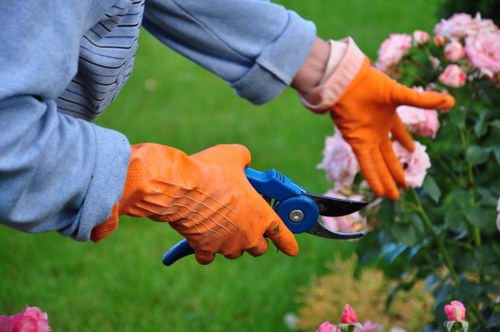Mastering Hedge Trimming for a Beautiful Garden
Introduction to Hedge Trimming

Hedge trimming is an essential aspect of gardening that ensures your hedges remain healthy, aesthetically pleasing, and well-maintained. Proper trimming not only enhances the beauty of your garden but also promotes the growth and longevity of your hedges.
Regular maintenance through hedge trimming can prevent overgrowth, reduce the risk of disease, and maintain the desired shape and size of your hedges. Whether you are a seasoned gardener or a novice, understanding the fundamentals of hedge trimming is crucial for the success of your garden.
In this article, we will delve into the various techniques, tools, and best practices for effective hedge trimming, ensuring your garden remains a vibrant and inviting space.
Tools and Equipment for Hedge Trimming

Having the right tools is paramount to achieving precise and efficient hedge trimming. The selection of tools depends on the type and size of the hedges you are working with. Below are some essential tools every gardener should have:
- Pruning Shears: Ideal for small branches and fine trimming.
- Hedge Trimmers: Electric or gas-powered trimmers are perfect for larger hedges and bigger projects.
- Loppers: Useful for cutting through thicker branches that pruning shears can't handle.
- Gloves and Safety Gear: Protects your hands and eyes during the trimming process.
- Cleaning Supplies: Keeping your tools clean ensures they remain effective and prolongs their lifespan.
Techniques for Effective Hedge Trimming

Mastering the techniques of hedge trimming can significantly improve the health and appearance of your hedges. Here are some key techniques to consider:
- Shape Maintenance: Regularly trim your hedges to maintain their desired shape, whether it's formal, informal, or topiary.
- Timing: The best time to trim hedges is during the late winter or early spring before new growth begins.
- Cutting Angle: Make clean cuts at a slight angle to prevent water from accumulating on the cut surface, reducing the risk of disease.
- Height Control: Ensure that all sides of the hedge are trimmed evenly to promote balanced growth.
- Thinning: Remove any dead, diseased, or overcrowded branches to improve air circulation and sunlight penetration.
Maintaining Healthy Hedges

Healthy hedges are the cornerstone of a beautiful garden. Proper trimming plays a significant role in maintaining the health of your hedges by:
- Promoting new growth and rejuvenation.
- Preventing the spread of pests and diseases.
- Encouraging dense foliage and a fuller appearance.
- Reducing the likelihood of branches breaking under weight or stress.
- Ensuring the structural integrity of the hedge, making it resilient to weather conditions.
In addition to trimming, regular watering, fertilizing, and mulching are essential practices to support the overall health of your hedges.
Common Mistakes to Avoid

Even experienced gardeners can make mistakes when trimming hedges. Being aware of these common pitfalls can help you achieve better results:
- Over-Trimming: Cutting back too much can stress the plant and inhibit future growth.
- Incorrect Timing: Trimming at the wrong time of year can disrupt the plant's natural growth cycle.
- Poorly Maintained Tools: Dull or dirty tools can cause uneven cuts and spread diseases.
- Ignoring Plant Health: Failing to address underlying health issues can worsen the condition of your hedges.
- Uneven Cuts: Inconsistent trimming can lead to an asymmetrical appearance and unbalanced growth.
By avoiding these common mistakes, you can ensure that your hedge trimming efforts are both effective and beneficial for your garden.
Seasonal Hedge Trimming Tips
Different seasons require different approaches to hedge trimming. Adapting your trimming techniques to the changing seasons can enhance the growth and appearance of your hedges:
- Spring: Focus on shaping and removing any winter damage, preparing the hedge for new growth.
- Summer: Perform light trimming to maintain shape and encourage dense foliage.
- Autumn: Clean up and reinforce the hedge in preparation for winter, removing any dead or diseased branches.
- Winter: Minimal trimming, focusing on maintaining the hedge's structure and preventing damage from harsh weather.
Spring Trimming
Spring is an optimal time for hedge trimming as it allows you to remove any winter damage and stimulate new growth. Start by cleaning the hedge, removing any debris, and cutting back to the desired shape.
Summer Maintenance
During the summer months, perform light trimming to keep your hedges looking neat. Avoid heavy trimming during this period to prevent stress on the plants.
Autumn Preparation
In autumn, focus on reinforcing your hedges by removing any dead or diseased branches. This helps prepare the hedge for the upcoming winter months.
Winter Care
Winter trimming should be minimal, primarily focusing on maintaining the hedge's structure and preventing any damage from snow or ice accumulation.
Choosing the Right Hedge for Your Garden
Selecting the appropriate hedge for your garden is crucial for successful trimming and maintenance. Consider the following factors when choosing your hedges:
- Climate: Choose plants that thrive in your local climate to ensure healthy growth.
- Purpose: Determine whether the hedge is for privacy, decoration, or as a windbreak.
- Growth Rate: Consider the growth rate of different hedge species to plan your trimming schedule accordingly.
- Maintenance: Some hedges require more frequent trimming and care than others.
- Height and Spread: Plan for the mature size of the hedge to ensure it fits well within your garden space.
Popular Hedge Varieties
- Boxwood: A classic choice for formal gardens, offering dense foliage and a slow growth rate.
- Privet: Known for its rapid growth and versatility in shaping.
- Laurel: A robust hedge option with glossy leaves and a tall growth habit.
- Yew: A long-lived hedge with dark green foliage, ideal for high pruning.
- Holly: Provides attractive berries and spiky leaves, adding both color and texture.
Professional Hedge Trimming Services
While DIY hedge trimming can be rewarding, sometimes professional services are the best option for achieving impeccable results. Professional gardeners have the expertise, tools, and experience to handle even the most challenging trimming tasks.
- Expertise: Professionals understand the specific needs of different hedge species and can tailor their trimming techniques accordingly.
- Efficiency: With the right tools and experience, professionals can complete trimming tasks more quickly and effectively.
- Safety: Trimming large or tall hedges can pose safety risks. Professionals are trained to handle these tasks safely.
- Aesthetic Results: Professional trimming ensures your hedges are shaped perfectly, enhancing the overall appearance of your garden.
- Long-Term Health: Proper trimming by professionals can improve the health and longevity of your hedges.
If you're considering professional hedge trimming services, contact us today to schedule a consultation and give your garden the care it deserves.
Conclusion
Hedge trimming is a vital practice for maintaining the beauty and health of your garden. By understanding the right tools, techniques, and timing, you can ensure your hedges remain vibrant and well-shaped throughout the year.
Whether you choose to undertake hedge trimming yourself or enlist the help of professional gardeners, the key is consistency and attention to detail. Regular maintenance not only enhances the aesthetic appeal of your garden but also promotes the overall wellbeing of your hedges.
Embrace the art of hedge trimming and transform your garden into a lush, inviting sanctuary.
Ready to elevate your garden's beauty? Contact us today to book your hedge trimming service and experience the difference professional care can make.



